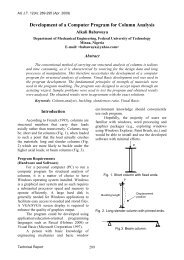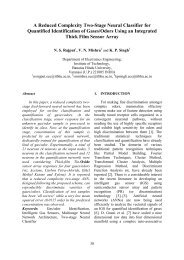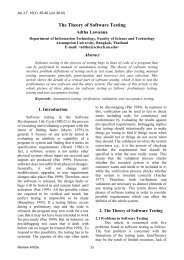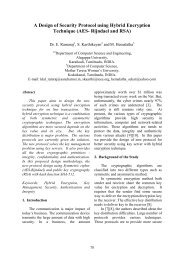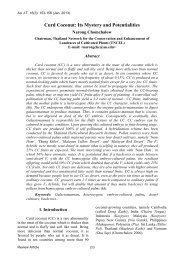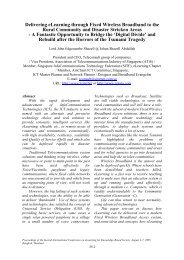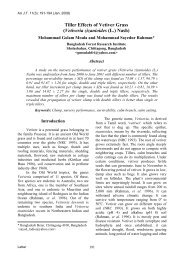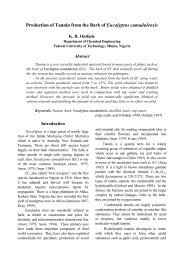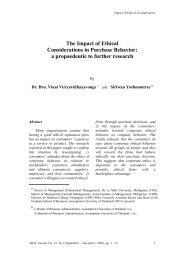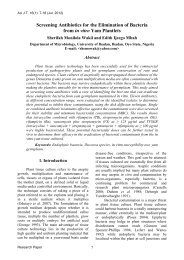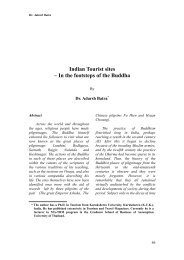PDF format - AU Journal - Assumption University of Thailand
PDF format - AU Journal - Assumption University of Thailand
PDF format - AU Journal - Assumption University of Thailand
Create successful ePaper yourself
Turn your PDF publications into a flip-book with our unique Google optimized e-Paper software.
continues to evolve and the<br />
teaching/learning process continues to<br />
be transformed through practice and<br />
research, nevertheless, the problems<br />
and challenges confronting the<br />
pr<strong>of</strong>ession will remain. Moreover, as<br />
the problems change, so too will the<br />
solutions (Nunan, 1995, p. 155). As<br />
Nunan observes “it is up to each <strong>of</strong> us,<br />
as pr<strong>of</strong>essionals, neither to accept<br />
proposals uncritically, nor to reject<br />
them out <strong>of</strong> hand but to reflect upon<br />
them and to contest them against the<br />
reality <strong>of</strong> our own context and<br />
situation” (Nunan 1995, p. 155).<br />
Also, it is not clearly evident, from<br />
the survey results obtained, to what<br />
extent Thai ELT educators do reflect<br />
upon the ELT syllabus design, teaching<br />
methodologies, and testing and<br />
assessment used in the West. This issue<br />
<strong>of</strong> transferability to the Thai context <strong>of</strong><br />
many <strong>of</strong> the theories and practices has<br />
been noted by a number <strong>of</strong> theorists.<br />
Holliday (1992), for example, discusses<br />
the idea <strong>of</strong> ‘tissue rejection’, the term<br />
taken from medicine, “where it is used<br />
to describe cases in which organ<br />
transplant fails because it is not<br />
accepted by the host” (P. 403). Tissue<br />
rejection, according to Holliday, takes<br />
place when the implant, in the form <strong>of</strong><br />
courses or materials, or <strong>of</strong> a fledgling<br />
institution such as a language centre or<br />
department which the project attempts<br />
to set up “does not survive as an<br />
integral part <strong>of</strong> the host institution, once<br />
project support is taken away”<br />
(Holliday, 1992, P. 403). An<br />
appreciation, suggests Holliday, <strong>of</strong> the<br />
conventions that organized ELT<br />
practices in <strong>Thailand</strong> must be within the<br />
experience <strong>of</strong> the providers <strong>of</strong> training<br />
if there is to be any transfer (Holliday<br />
1992, P. 403-404). However, the<br />
degree <strong>of</strong> ‘tissue rejection’ in the Thai<br />
context is uncertain. Further research is<br />
required on this issue so that it is<br />
possible to create “ways in which<br />
specialist practitioners in the field may<br />
reduce, through greater sensitivity to<br />
local cultures, possibly negative effects<br />
<strong>of</strong> what they are doing, and work to<br />
achieve maximum benefit for local<br />
people” (Holliday, 1992, P. 403).<br />
Linguistic Variables Essentially Need<br />
To Be Considered In Designing a<br />
Syllabus<br />
Also, it is essential to consider<br />
linguistic variables. For example,<br />
Prescott (1995) notes that, “native<br />
speakers <strong>of</strong> English find some<br />
languages more difficult to learn than<br />
others”. A course must, therefore<br />
“address issues such as linguistic<br />
variables. It must consider how the<br />
linguistic differences between particular<br />
Asian languages and English affect the<br />
learning <strong>of</strong> English by speakers <strong>of</strong> those<br />
languages” (P. 97). These differences,<br />
no doubt, will affect methodology.<br />
Cultural Variables Affecting English<br />
Language Teaching<br />
Another important issue is cultural<br />
variables since these affect “the way



